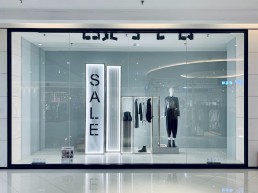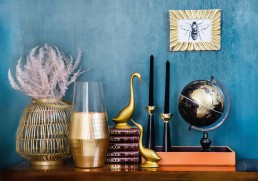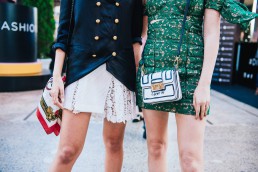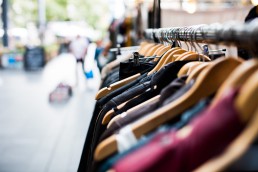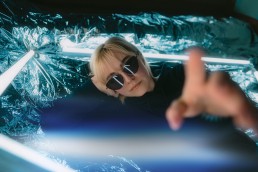What is an “Omnichannel”?
Do you always hear the term “omnichannel”, but don’t know what it means? No worries! Today we will tell what it means, what it consists of, and why it is relevant in the fashion industry.
The can be defined in various ways, but it essentially is a strategy that involves a brand’s presence online and offline, or digital and physical, and how that presence stays coherent and singular to a customer.
Omnichannels are there to create a personalized customer experience that allows the individual to interact with the brand in their preferred way since customers increasingly check out the products they like through different channels.
Nowadays, with an increasing number of channels and devices in which brands can interact with consumers, brands need to be more creative to maintain their customers engaged. However, to make individuals loyal to a brand they need to trust it, and to gain that trust, consistency is a must. So a strong strategy requires an experience across channels that is also cohesive, in other words it is not enough to just be present in different ways.
For retail, an omnichannel strategy is essential, retail brands with a strong omnichannel strategy have a retention of 89%, as opposed to 33% when this one is weak.
Due to its lifestyle orientation, a strong omnichannel strategy is absolutely necessary in fashion. Are you ready to take on the challenge to build the future of the industry? Check out our Retail Management and Digital Customer Experience Diploma Course, available worldwide.
What Goes in the Platinum Area of a Sales Floor?
The role of visual merchandisers is to create an in-store experience that captures the attention of the customer, makes the customer return, and most importantly, that maximizes sales. In addition to window dressing, which will capture the attention of people passing by, product positioning is key for visual merchandisers!
There are techniques to determine where each product should go, floor layouts are usually divided into the platinum, gold, silver, and bronze areas. Platinum being the area at the beginning of the store, and bronze being at the back. Letters and numbers are also used to define these areas. The ultimate goal is to make a journey for the customer that keeps their interest in going through the store.
The platinum area, as mentioned before, is located right at the front of the store. This area has to be full of the items you want incoming customers to see: items on sale, high fashion items, promotional items, should all be placed in this area, this is the hook for the store; in other words, this is what will make the customer continue exploring the store.
In this sense a lot of work must go into the platinum area as it sets up the rest of the customer’s journey with your brand.
Want to know more about visual merchandising? Check out our Visual Merchandising and Fashion Stylist Diploma Course!
The Profile of an Interior Designer
Interior Designers design functional and aesthetic places for their clients, their role includes searching and bidding for projects, creating design plans, specifying which materials are to be used for the decoration of the space (lighting, furniture, wall finishes, flooring, etc.), coordinating with contractors, and ensuring the client is satisfied with how the vision has materialized.
For this reason Interior Designers must be:
Creative
They have to visualize a space that serves the client’s vision and lifestyle
Artistic
Interior Designers use their aesthetic eye to create designs and spaces that are pleasing and create an environment
Detail Oriented
To achieve success in this career path it is important to be exact and select everything in the space to create the desired environment
Problem Solvers
Construction delays, increases of costs, unavailability of materials, and staying within budget despite changes in plans are some of the challenges faced by Interior Designers and they must be addressed with calm and preciseness.
People Oriented
Due to their role involving a lot of coordination between different contractors, they must communicate well with clients, engineers, and all the parties involved in the creation of a space
Spatially Aware
Interior Designers must have strong visualization skills and understanding of proportions.
If you have these skills or would like to build them up join our Diploma Course on Interior Design!
Trends in Product Design
As the use of technology increases, we see a shift in a many aspects of our life including moving towards the combination of the digital and physical world; pushing for convenience; and appreciating less materialistic pleasures.
Based on the five points presented by Ryan Chen, Director of Design & Innovation Strategy at the Bressler Group, we will look at 5 trends in Product Design.
- Uniqueness
The traditional attitude towards luxury is changing. First, it has become less socially acceptable to show off huge disparities of wealth. Second, products now are made in different price ranges making them available to a wide audience, so the concept of “exclusiveness” has a different connotation.
Consumers just want timeless products! This is what will make an item unique. Product Designers have begun making higher-end offers of the same product, fulfilling the demand for a subtly luxurious experience.
- Experience
When we talk about experiences we must talk about services, they extend beyond the ownership of something physical and offer intangible moments that connect with the consumer’s emotion.
As today’s society that moves away from materialism it starts to value the fact that services cannot get lost, and are flexible enough to fit an individual’s circumstances.
Product Designers are concentrating on finding the root of the desire for any product, satisfying said desire will determine the consumer’s experience with it. They are also adding service components to existing products to create more personalized experiences.
- Convenience
In today’s fast-paced society individuals do everything possible to save time. With the increase of affordable services and technology many individuals get away from performing any unpleasant tasks, thus, increasing the demand for convenience!
For this reason Product Designers are adding intelligence to products and interactions, and should find opportunities to automate where possible. All, of course, to simplify the consumer experience making them spend less time and effort in their interactions with the product.
- Wellness
With more general education about health, and a change in perspective in how much we can contribute to our own through lifestyle choices, an increasing part of the population, specially the affluent, tend to seek products that contribute to their wellness.
As self-care becomes more important, all wellness-oriented buys are becoming a marker for exclusivity and luxury. Product Designers or manufacturers are making partnerships with wellness-focused firms that can bring benefits for both.
- Ethical Living
Ethical living is a trend that is changing the way all industries operate. Constant media coverage of these issues have made consumers aware of how buying products contributes to society as a whole. Companies are held to higher standards of behavior than ever before, and consumers want less but with a higher quality.
Consumers are willing to spend more, if it means the product they are purchasing will have a long life, and a lot of utility. For this reason, Product Designers are taking longevity, repairability, and multi-functionality into account for their products.
They are also adopting aesthetics that inspire “honesty” and “simplicity”. In all, consumers are willing to pay more if the products they purchase make sense in these terms.
Are you an aspiring Product Designer? Learn more about this industry and gain the tools to lead in your profession. Check out our short course!
Why Study Influencer Marketing?
Influencer Marketing started off as a secondary marketing activity for firms to support their traditional advertising campaigns, however, the effectiveness of this innovative type of marketing transformed this secondary activity into a 5-10 billion USD industry. As consumers demand more genuine interactions with brands, influencers become the image of authentic endorsement, that is, if influencer and brand partnerships are done correctly.
The influencer market has grown significantly, this means a larger pool of influencers, and a larger pool of choice for brands. Scandals of fake followers are widely known, and choosing the wrong influencer can mean losses for firms. When brands and influencers achieve the right pairing however, firms can benefit greatly. To avoid mistakes both firms and influencers increasingly choose to have a mediator. In the case of influencers, Talent Managers, and in the case of firms, assigning an expert position that deals exclusively with this type of campaigns or hiring a specialized agency.
Our Influencer Marketing short course prepares students to be the corporate mediator firms need. One of the main requirements to make Influencer Marketing successful is having an effective plan for sponsored content, in our program we teach our students how to lead a successful campaign, how to measure the outcome, and how to report it their superiors or clients.
Our program also prepares students to reach out to digital talent, to manage legal affairs as well as how to deal with Talent Managers, and logistics. Additionally, it provides students with thorough knowledge on trends and channels.
If you want to join industry, start out by gaining the knowledge you need to succeed.
What is the Best Part of Studying Online?
Coco Chanel once said “You were born an original, don't become a copy”, and that's what inspired me to do something new.
The relationship between the question "What is the best part of studying online?" and this quote surfaces when this and my career in fashion merge. When I entered to study Fashion Design, I realized that there are too many branches related to fashion, not just making patterns and sewing, you also study history, trends, communication, among other topics related to fashion. When I started, I realized that most of my colleagues dreamed of creating their brand and having a store, then I wondered, do I dream about having my own brand?
After thinking about it, I realized that my true passion was to spread knowledge about fashion, to transmit what I am so passionate about to others and learn more about it. Here is where the question with the aforementioned phrase works. My dream is to stand out, to learn and improve my knowledge in the world of fashion, I wanted to begin to form my professional career, so I started with my blog "SHE by Priscilla Gómez" but I believed that in order to transmit more knowledge about fashion and enchant others with it I had to improve, to learn, and to become a professional in what I love, so that's how I discovered ELLE Education.
I believe that studying online is one of the best opportunities that we have as students to grow and to improve, not only academically but also personally. Studying online helps to get to know other cultures, more ways to discover other learning experiences, and the most important thing, it provides the the opportunity to have courses, diplomas, where experts teach you from the point of view based on their experience.
The opportunity I found in studying online is that I get to learn by myself and to know what I am capable of and what really want to do, I get to show myself that the world of fashion goes beyond what we think it is.
When I decided to stay in my hometown to study Fashion, I thought that I wouldn't be able to have big opportunities to improve myself, I believed that by studying fashion my only goal would be having my clothing brand. Nowadays, thanks to the opportunity of studying online, I know that that's not true, I know that having my own brand is not my only purpose, but on the opposite, I can dedicate to writing about my passion for fashion, which is what I love the most.
ELLE Education fulfills the purpose of studying online, which means providing us with an incredible opportunity that helps us grow not only in a professional way but in a personal way, and at the same time, transmitting that to society; making them learn with us.
Priscilla Gomez(Marketing and Communications for Fashion and Luxury Brands)
New Courses on our Platform!
ELLE Education was launched as a platform in March of this year, it started off with two diploma courses and three short courses. We are proud to announce that our education offer continues to expand to fulfill the demand for flexible, and high quality education in the fashion and events sectors. In this upcoming October intake the second edition of our initial three short courses will be accompanied by three new courses, and more to be launched in the upcoming months. These short courses will be following the same format, a two month duration, 100% online, and will continue to combine academic and practical knowledge to prepare you for your career.
Name of the course: Fashion and Lifestyle Branding
Who should take this course?:
-Individuals who want to start a career in branding
-Professionals who want to understand how to make their brand stronger
-Entrepreneurs who want to solidify their brands
Career paths:
-Branding Consultant
-Marketing Manager
Name of the course: Product Design
Who should take this course?:
-Individuals interested in this career
-Individuals who want to run their personal brand
-Entrepreneurs who plan to create their own design
Career paths:
-Product Designer
-Industrial design researcher
-Creative director
Name of the course: Influencer Marketing
Who should take this course?:
-Individuals who want to work as the mediator between influencers and brands
-Entrepreneurs who want to start working with influencers
-Marketing specialists who want to gain knowledge in this area of marketing
-Influencers who want a better look at how the industry works and their role in it
Career paths:
-Mediator between influencers and brands
-Partnership Manager
If you want more details about these courses or want to see the whole education offer check out our programs here!
Why I Chose ELLE Education
The name, ELLE, itself, means FASHION. A brand that famous celebrities prefer to wear because of its stylish and elegance. I did not have a second thought of choosing ELLE EDUCATION.
My generation caters mostly on designs that express their moods and their characters. Something that express their feelings even through accessories! Times have changed and we have to go with the flow of society.
I believe that I have a passion for fashion since I am always attracted to new trends and new designs I find in magazines. I actually have enrolled a short course in Bahrain. I learned how to sew, how to blend color combinations and the type of cloth and materials needed for certain outfits.
And now that I found ELLE EDUCATION, it is my utmost dream to pursue a better career from a renowned World class Company. I fully trust ELLE EDUCATION and I know that someday I will become a famous Fashion Designer under its professional tutelage.
Laila Almalki (How to Create a Brand)
Examples of Pilot Stores by Industry Giants!
Pilot stores are defined as “a prototype store used to test management practices, systems and products”. These stores have one clear objective and raison d'être: to attract new customers!
Industry giants pick their best stores to test out new initiatives that could change their business for the better. The importance of a pilot store is to have a controlled environment where data can be collected before engaging in a transformation to a large scale. This is particularly important for retail brands present all over the world. Today we will take a look at two examples in fashion retail brands: Zara and H&M
H&M
After a brief dip in sales in 2018, H&M opted for focusing on creating experiences for its customers rather than change their products. In other words, it wanted to test a more luxurious approach, which some of its competitors were already doing.
It started off with a pilot store in the upmarket of Karlaplan, Stockholm, where the stored offered a more selective choice of clothes in a color coordinated manner, testing out its visual merchandising techniques. The store also offered coffee as well as exclusive events for loyalty club members, including yoga classes, and mingle events. Overall the idea was to get much closer to the consumer and create a more personal attachment.
This pilot served H&M to see where to go next with its consumer!
Zara
Zara tends to opt for an identical layout and aesthetic worldwide. Visual merchandisers at HQ use pilot stores to test the interior design of each store in each of its categories (women, men, home).
However, these pilot stores are off-limits to the public and located in Zara HQ, they are used exclusively to experiment with the “look and feel” of the store before releasing any new collections, receiving new items twice a week.
Visual merchandisers and 31 architects determine the most visually pleasing, and most logical layout for the Zara stores worldwide. They also work with retail managers to adapt their techniques locally to each store.
We have seen two different examples of the use of pilot stores by industry giants. If you find retail fascinating join our diploma course International Retail Management before July 26th!
How to Identify the 4 P’s of Your Business
The most simplistic way to describe marketing is “placing the correct product in the correct place, at the right time”. As per usual the simplest ideas turn into the most complicated! Not to fret, marketers have been researching for years how to simplify this process, and have come up with: Marketing Mix or the Four P’s.
The four P’s are: Product, Price, Place and Promotion. These are interdependent variables that help achieve marketing targets. These variables are flexible and fluid they change according to marketing conditions and consumer wants and needs. They need constant monitoring by the Marketing Manager, and should at all times have the customer as the focal point.
In order to identify them you must understand fully what each variable entails:
Product: A tangible good or an intangible service.
Price: The value of this tangible or intangible service.
Promotion: The channels where you communicate to the consumer, i.e. advertising, public relations, social media marketing, email marketing, search engine marketing, video marketing, etc.
Place: Location of the customer journey.
Now let’s take a look at some questions to consider when it comes to defining the strategy around the four P’s:
What do consumers want from your product, how does it differ from others?
How does your product answer the consumer’s needs?
Where do your potential buyers spend their time?
How do they value your product?
How do you already interact with potential customers?
Do not shy away from “why” questions or “what if” situations this will help your analysis, and also know that this process will be constant and the consumer anf their preferences change regularly in this highly competitive globalized market.

